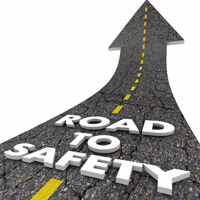Roadway Design Improvements Make Roadways Safer
November 28, 2017 Each year, over 32,000 people are fatally injured, and thousands more seriously injured in car accidents in the United States. Car accidents are caused by a range of factors, including drunk driving, distracted driving, drowsy driving, and aggressive driving, to name a few. Poor road conditions, and poorly designed roadways can also create hazardous driving conditions that often result in serious car accidents. By upgrading and improving many of the streets, roads, expressways, and highways across the country, motorists, cyclists, and pedestrians are less likely to be injured in a car accident.
Each year, over 32,000 people are fatally injured, and thousands more seriously injured in car accidents in the United States. Car accidents are caused by a range of factors, including drunk driving, distracted driving, drowsy driving, and aggressive driving, to name a few. Poor road conditions, and poorly designed roadways can also create hazardous driving conditions that often result in serious car accidents. By upgrading and improving many of the streets, roads, expressways, and highways across the country, motorists, cyclists, and pedestrians are less likely to be injured in a car accident.
The Federal Highway Administration (FHA) has made several recommendations on how to decrease the number of injuries and fatalities related to roadway conditions. To date, approval to move forward with these improvements has been stalled by a lack of funding. Some of the recommendations made by the FHA include the following:
- Install rumble strips: If a driver veers out of the lane, rumble strips installed on shoulders and center lines will cause the vehicle to vibrate, warning the driver that he or she is departing the lane. Studies show that rumble strips can reduce the incidence of sideswipe crashes and head-on collisions by 14 percent and “run off the road” accidents by 38 percent on freeways and 18 percent on rural roads.
- Install median barriers: Median barriers are effective at reducing the number of cross median accidents. The National Highway Traffic Safety Administration urges all states to continue using these barriers in areas where it is appropriate.
- Design roads that have safety edges: Safety edges are a paving design that incorporate a 35-degree slope along the outer edge of the road. This can prevent a vehicle from falling over the edge of the road.
- Install roundabouts: Roundabouts can reduce car accidents by up to 87 percent. In addition, they improve the flow of traffic at certain intersections and eliminate the need for stoplights.
- Improve turning lanes: Roads that have multiple turning lanes tend to be more efficient, maximizing traffic flow. Well-designed turning lanes at stop-controlled intersections may reduce car accidents by close to 55 percent.
- Properly set traffic signals: By adjusting the length of the yellow light to remain lit for one second longer before it changes to red, this can significantly reduce the number of red light violations and serious car accidents.
- Install pedestrian refuge areas: The FHA recommends that raised medians that are four feet to eight feet wide be installed in appropriate areas in order to improve safety for pedestrians and cyclists.
- Design roads with improved walkways: By installing pathways or sidewalks along roadways, it can reduce pedestrian-related accidents by close to 90 percent.
Baltimore Car Accident Lawyers at LeViness, Tolzman & Hamilton Represent Victims of Car Accidents
If you have been injured in a car accident involving poor, or unsafe roadways, contact the Baltimore car accident lawyers at LeViness, Tolzman & Hamilton as soon as possible. We are on your side and will seek the maximum financial compensation you deserve for your injuries. Our dedicated and experienced team will recommend the best legal course of action and ensure that your rights are protected. To schedule a free consultation, call us today at 800-547-4LAW (4529) or contact us online.
Our offices are located in Baltimore, Columbia, Glen Burnie, and Towson, allowing us to represent car accident victims in Maryland, including those in Anne Arundel County, Carroll County, Harford County, Howard County, Montgomery County, Maryland’s Western Counties, Southern Maryland, and the Eastern Shore, as well as the communities of Catonsville, Essex, Halethorpe, Middle River, Rosedale, Gwynn Oak, Brooklandville, Dundalk, Pikesville, Nottingham, Windsor Mill, Lutherville, Timonium, Sparrows Point, Ridgewood, and Elkridge.






